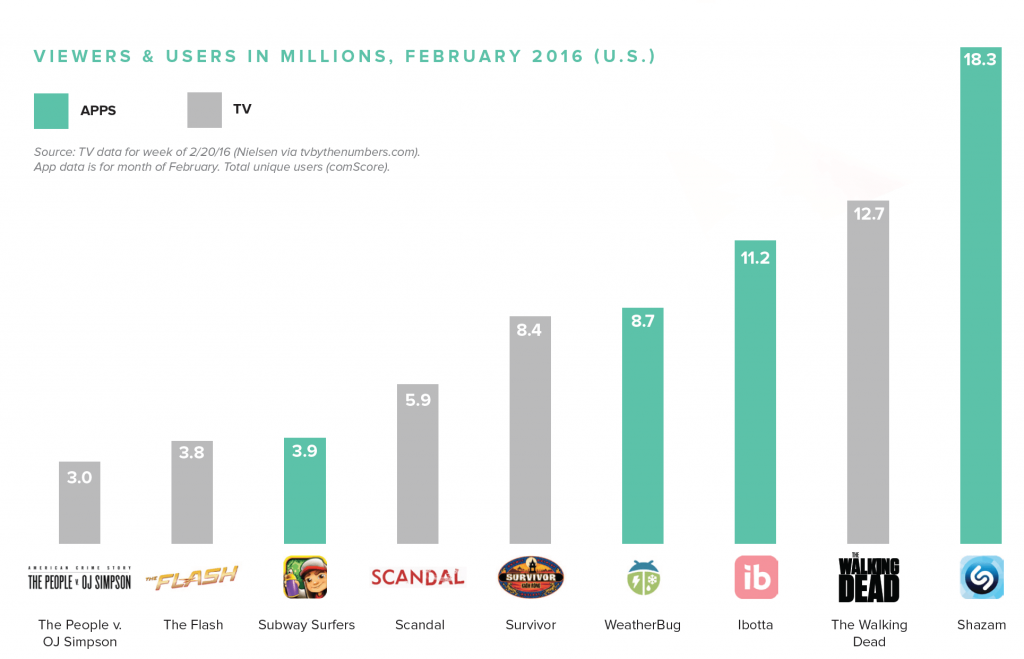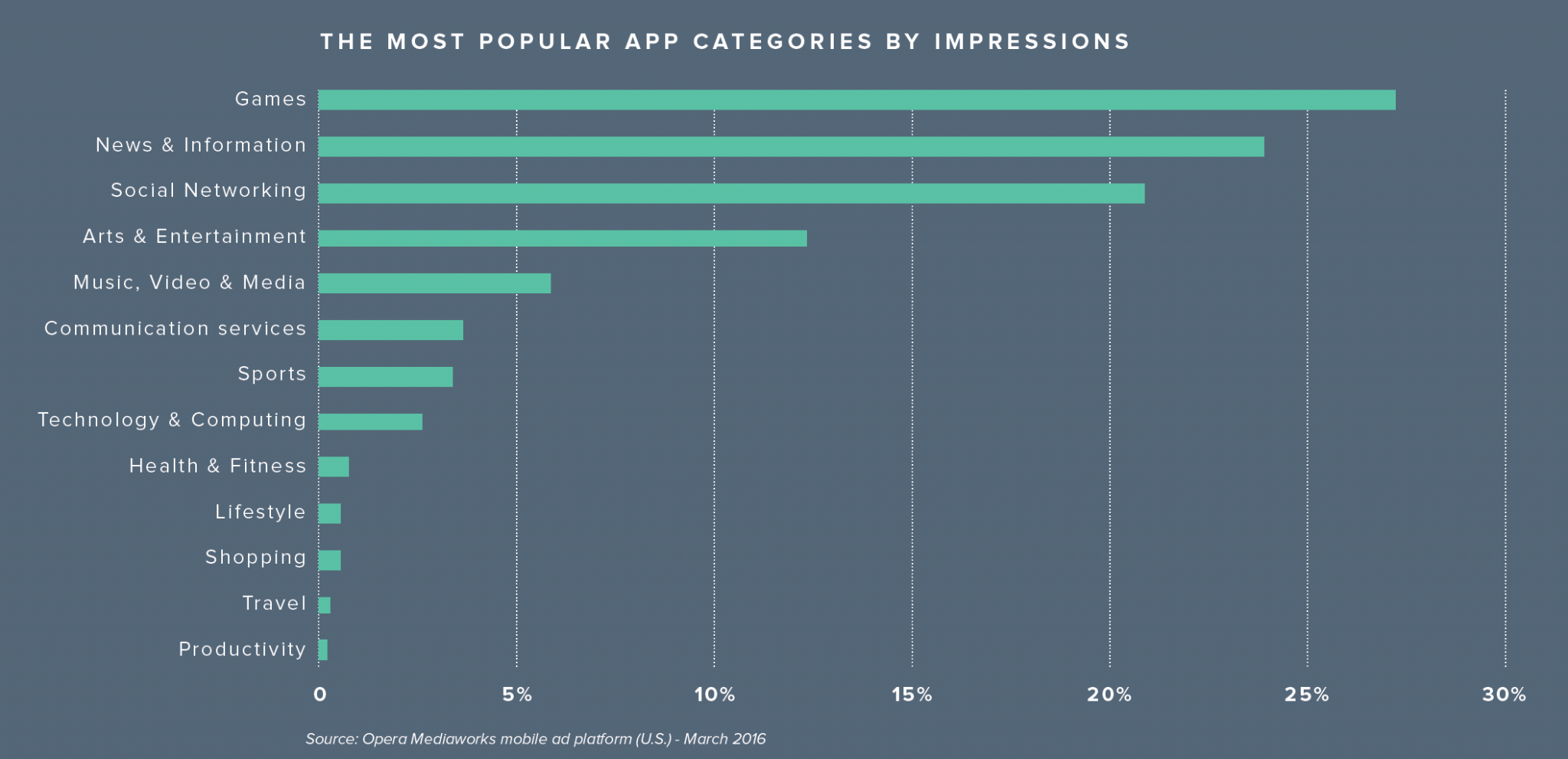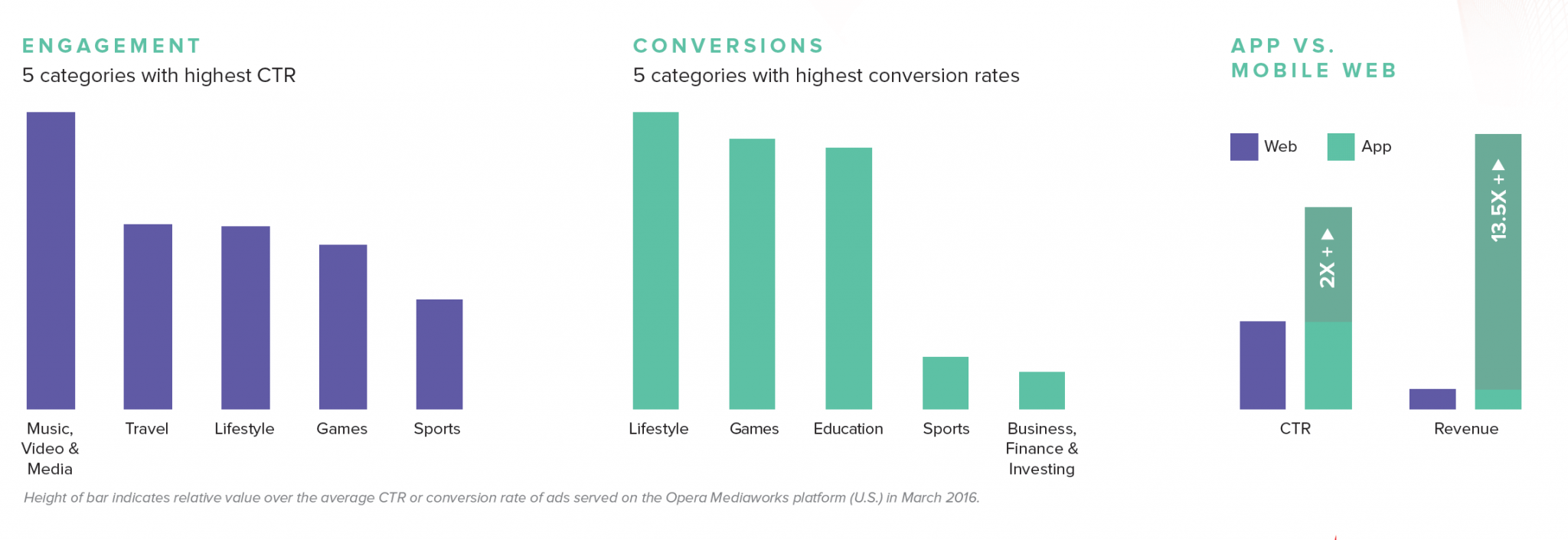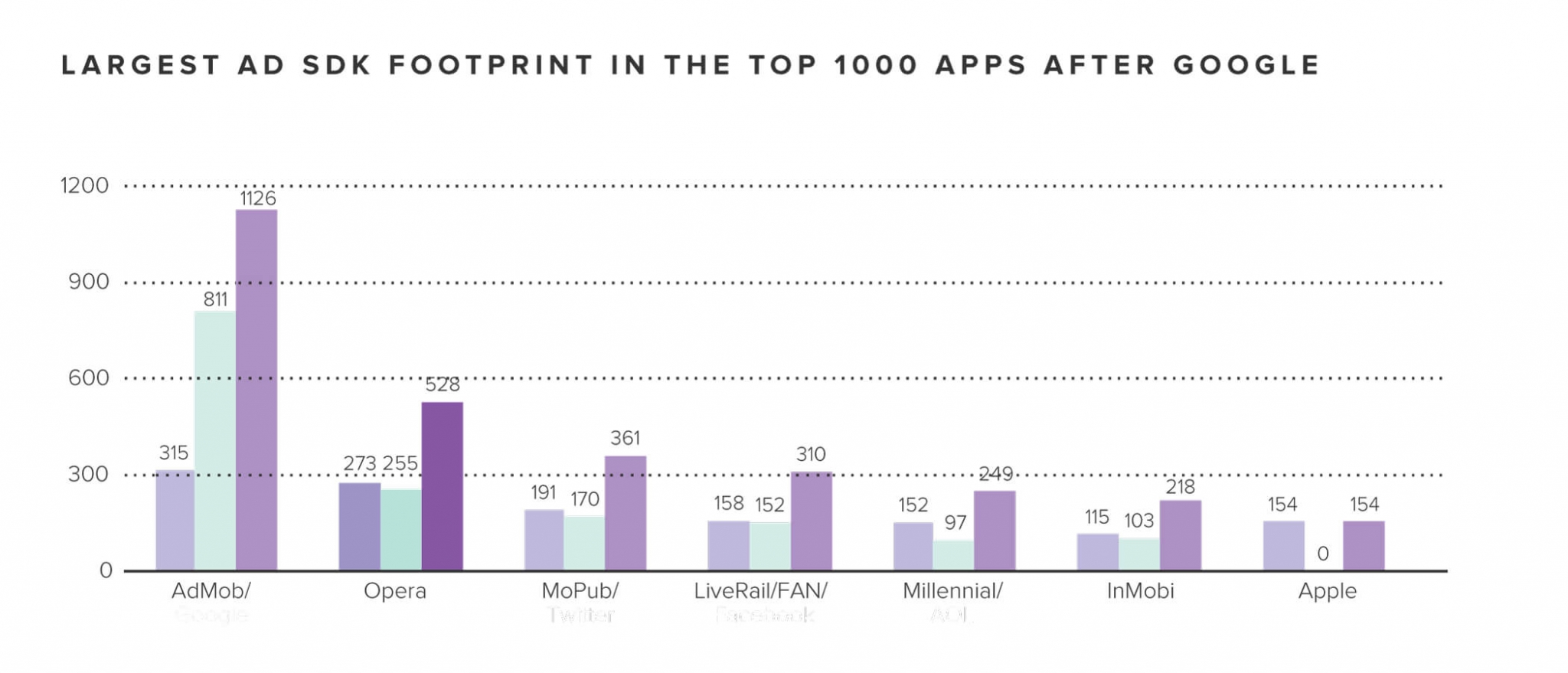INTRODUCTION
A quarterly mobile marketing report from Opera Mediaworks.
The world’s highest quality mobile advertising and marketing platform
DATA
With their TV-sized reach, long session times and high levels of engagement, Games and Entertainment are “must buy” categories for mobile marketers
TECHNOLOGY
Targeting quality is a key success factor for mobile; choose an advertising partner with direct SDK penetration to increase data signal accuracy.
CREATIVITY
Creative matters! Purpose-built mobile creative, such as Hilton Hotels & Resorts’ 360° video and Stoli’s haptic effects, delivers surprise and delight for consumers, awards for marketers and ROI
DATA
How many apps do you have on your phone? How many of those do you use daily, weekly, or monthly? Chances are, only a handful.
According to comScore’s 2015 U.S. Mobile App Report, nearly four out of five smartphone app minutes are spent in the user’s top three apps. It’s important to note that these three apps are not the same for everyone – they are different for each person, just as everyone’s home screen is a unique combination of their most-used apps.
Looking at the data from the Top 100 apps that use Opera Mediaworks to monetize their traffic, we can see that mobile users are spending about 30 minutes each day in each of these popular apps, with an average session length of over 8 minutes, so it is clear that these audiences are committed to and engaged in the app’s content – unlike other forms of media from which the user’s attention is quickly diverted.
“Mobile users are spending 30 minutes a day in the Top 100 apps – and the average session length is 8 minutes.”

MOBILE IS NOW REACHING TV-SIZED AUDIENCES
While time spent each day, or month, is a solid measure of the significant role that mobile apps are now playing in our everyday lives, there is another metric that advertisers care deeply about: reach. Until recently, there was a perception that mobile took a backseat to other media when it came to volume. But as seen in the chart below, mobile now has the ability to reach TV-sized audiences, with some mobile apps surpassing the reach of popular TV shows like The Walking Dead, Survivor and Scandal.

THE GO-TO SOURCE FOR ENTERTAINMENT
Despite what we hear about the ongoing adoption of social media and messaging apps, and the emergence of m-commerce, the primary driver of this time spent is not either of these categories.
Even mobile search, which has been lauded as overtaking desktop search in 2015, is not taking up the majority of this mobile time. Mobile search fits more into the category of “micro-moments,” where decisions are made for their immediacy and utility (I want this now) and they don’t lead to long-term loyalty and engagement with a brand.
DRIVING RESULTS IN TODAY’S PREMIUM
So what is driving all of this time spent? Without a doubt, it is apps that serve entertainment and educational purposes.
Games was the top category for impressions served on Opera’s mobile-ad platform in the
United States in March, followed by News & Information. Social Networking was no. 3, followed by
Arts & Entertainment and Music, Video & Media.

It is not surprising that apps in these categories are experiencing such tremendous growth, because they are providing real value to mobile users.
In fact, they are what we are calling “Today’s Premium.” And in such a trusted, highquality app environment, it is also not surprising that it is where we find the most ad value. Advertising campaigns running in these categories are seeing higher levels of engagement than any other, and in many cases, higher conversions as well.
Finally, while comparing the value of apps vs. mobile web on our mobile ad platform, we can see that while the number of impressions served on mobile apps vs. mobile web are comparable, the click-through rate for apps is more than twice that of mobile web, and the revenue generated from advertising is more than 13X.

TECHNOLOGY
Knowing where your potential customer is spending time on their mobile device – or even knowing when and how they are interacting with advertising within those apps – is only half the battle. Popular apps, consumer behavioral data and mobile-ad engagement hotspots will give you a vision of what you want to do, but it won’t help you realize that vision.
Why? Because there are different types of access to mobile-ad supply. On the bottom rung, there is “indirect access,” where the the buyer does not have a relationship with the publisher and thus goes through an intermediary such as a mobile ad exchange.
More premium access comes from a direct relationship between advertiser and publisher – but there are different levels. On the low end, you might have direct access, but only through webview tags, which means there are severe limitations to what you can do within that app. For instance, you would not be able to pre-load a video, only stream it – which in today’s world of variable mobile connection speeds, many of which are still quite poor, can often degrade the outlook for a mobile video campaign.
In the most premium of relationships, the publisher will integrate their partner’s ‘SDK’, or software development kit. When the apps that you want to advertise in use the mobile-ad SDK of your advertising partner, the world opens up.
In this premium tier, you can run Instant-Play™ video, which is pre-loaded HD video content that streams instantly, with no buffering or graininess. You can use haptic effects or other proprietary ad units that tap into the native features of the device. Instead of choosing “lowest common denominator” creative that will run reliably everywhere, you can create truly customized campaigns that work seamlessly within the SDK.
But there is another reason a mobile ad SDK dramatically improves the ad experience that goes beyond custom creative – and it has nothing to do with high-resolution or speedy delivery.

One of the greatest benefits of mobile advertising is the enormous menu of targeting options. On top of those that marketers are already familiar with from desktop (e.g., contextual, behavioral, demographic) there are those that are unique to mobile, such as device type, OS, carrier or GPS location. You can look internally within your ad network, data such as ads engaged with or in-network behavior, or look outward to integrate third-party data from other sources, like Nielsen, BlueKai, and even credit card partners.
CAN YOU TRUST YOUR TARGETING DATA?
But how much of that data can you really trust? Unfortunately, not much, if your access is indirect, because you cannot be certain the data hasn’t been obfuscated or altered in some way. At the most basic level, you need to know that the Advertising Identifier (IFA) for that device hasn’t been altered, otherwise your ability to match against offline data or segments based on traffic from other sources comes into question.
Take location, for example. If you are relying on lat/long from an indirect source, you cannot be fully confident the data represents the exact location of that user. It could look like GPS coordinates, but it might be a location derived from the IP address through which the user is connecting – so it could be the GPS coordinates of a central location in the city, zip code, state or country the user is believed to be in.
If you are working directly with the publisher, but without an SDK, you will have more faith in those key signals, but still no access to those signals yourself, so you don’t have 100% certainty.
However, when you have an SDK embedded within publisher partner apps, the trustworthiness of those data signals increases. You can pull the IFA directly and be assured that it should match up against the IFAs in your targeting database (or that of your partner). You will know exactly how the location signal was derived, whether from precise GPS capabilities or from more coarse location capabilities, and utilize the signal accordingly. Just as importantly, the SDK has access to a host of useful device characteristics that aid in presenting the right ad to the user, such as audio levels and screen characteristics.
And that’s really what SDKs are about: creating a trusted relationship between publisher and advertiser, which ultimately leads to greater opportunity for optimization and better outcomes against advertiser KPIs.
CREATIVITY
When you combine the amount of time consumers are spending on mobile with the way it is integrated so deeply into their lives, it is clear that mobile is the most personal of screens, too. It truly spans all aspects of our personal lives, from photos of our family, our complete social networks, music from our favorite artists, our favorite games – even our credit card and health information.
As such, the proverbial bar for advertisers is set far higher than that for other mediums. Consumers simply expect more from a brand when it presents itself in this kind of close, personal environment. Both advertisers and publishers have to deliver the highest quality experiences in order to maintain a strong level of trust and effectiveness.
The first way they can do this is through the power of context, that is, using the distinct signals unique to mobile (e.g., demographic and behavioral data, device signals, content type/environment, location, time of day, real-time conditions) to inform and drive the creative messaging. As a brand begins to consider what the ad experience should be for the consumer, they must activate those mobile-only signals, to be able to deliver a truly differentiated experience.
The second way is through the creative palette, or the native hardware and software capabilities that are built into mobile devices. From the camera, accelerometer and gyroscope to apps, mobile wallets and messaging platforms, each of these capabilities allows for an advertising experience that could only occur on a mobile device.
Many brands are now recognizing the potential impact of these experiences and are designing purpose-built mobile creative that activate those underlying capabilities. Here are two examples.
“Consumers simply expect more from a brand when it presents itself in this kind of close, personal environment.”
GO AHEAD, TURN AROUND
To provide potential vacation-goers with the feeling of what it would be like to stay at their property, Hilton created a campaign called “Our Stage, Your Story.” It begins with a short, scripted video ad, followed by an interactive end card. From there, the user is presented with a sequence of “stages” where they can explore a Hilton property through 3600 views by tilting their devices in different directions. In this way, they feel in control of their own story — the one that they will create at that Hilton resort.
“When the interactive portion begins, set at Hilton Barbados, the voiceover explains that this Hilton hotel is a launchpad for guests to discover new places, experience unique adventures and create their own story. Viewers are then presented with a sequence of ‘stages’ for that story: the ocean from inside of a sea cave, the expansive beach from a guestroom balcony, thick ferns all around them on a jungle walk – these virtual reality moments are what drive travelers to book their dream vacation, right then and there.”
HAPTIC EFFECTS
CAN YOU FEEL THAT?
Iconic spirits brand Stoli partnered with Opera Mediaworks and Immersion Corporation to create a mobile video ad that prompted the phone to vibrate in the user’s hand when the bartender in the ad shook a martini. A first-of-its-kind ad, it was delivered to 1 million users, with extraordinary results.
“Early consumer focus groups conducted by Immersion showed that media enhanced with tactile effects resulted in the increased feeling of immersion, intent to buy and brand recall.”
— Jason Patton, Vice President and General Manager of Content & Media, Immersion Corporation
“Time and time again, we’ve seen that designing and delivering purpose-built mobile advertising in Today’s Premium environments delivers higher response, engagement, brand health and performance-based outcomes than those run in a more ‘traditional,’ desktop-centric manner. Brands have the opportunity to use all of the technology built into these devices to directly enable a massive expansion and advancement of creative activation, connecting them to their customers in the most exciting, entertaining and organic of ways.”
— Ryan Griffin, SVP, Strategy, Opera Mediaworks
METHODOLOGY
All data cited as coming from “the Opera Mediaworks global ad platform” is based on aggregated information obtained from Opera Mediaworks mobile advertising platform and mobile ad exchange servers. The data presented represents track and monetization metrics and statistics compiled across multiple advertising campaigns delivered to us by our mobile publisher customers. The data includes ads requested from and delivered by us on behalf of multiple ad networks as well as directly sold campaign created by our customers themselves. Country-level details (e.g., United States only) are based on IP addresses of the originating ad requests as forwarded to us by our mobile publisher and app developer customers.
Other information contained in this report comes from third-party sources:
comScore:
2015 U.S. Mobile App Report
Nielsen:
Insights from Mobile NetView 3.0

Q1 BY THE NUMBERS
1.43B Monthly Active Users (Mar)
3000+ Apps (at least 100 requests)
added every month to our network
100 Apps added every day
New app added every 14 minutes





